Key to LACCARIA species of the Pacific Northwest
Prepared for the Pacific Northwest Key Council
By Anne Leathem and Brian Didier (Vancouver Mycological Society)
Copyright © October 16, 2012 Pacific Northwest Key Council
Photo copyright held by each photographer
Do not copy photos without permission
Adapted from Mueller, G.M. 1992. (see references)
KEY TO SPECIES
1a Fruitbody with violet pigment; may be restricted to mycelium at base of stem
................................................................................2
1b Fruitbody lacking violet pigment
................................................................................Laccaria laccata group 4
2a Entire fruitbody violet
................................................................................L. amethysteo-occidentalis
| CAP 10-65 (-89) mm broad, obtuse, convex or plane, often depressed, not striate when fresh, occasionally becoming slightly translucent-striate upon fading, finely fibrillose, fibrillose or fibrillose-scaly, hygrophanous, deep purple when fresh, fading to vinaceous, finally buff colour; margin inrolled, decurved or plane, entire to eroded; flesh thin, concolorous with cap with lighter gray-purple to white areas intermixed. ODOUR not distinctive. TASTE not distinctive. GILLS dark violaceous, becoming vinaceous; sinuate to arched, subdistant to distant, narrow to broad, thick, occasionally appearing waxy. STEM up to 115 mm long, strongly striate, concolorous with cap. BASAL MYCELIUM violet. HABIT and HABITAT under conifers (often Pseudotsuga menziesii), common, scattered to gregarious, August to October in western North America. MICROSTRUCTURES Spores white, 7.8-10.6 X 7-9.2 Ám, usually subglobose to broadly ellipsoid, spiny; spines mostly 0.5-1.4 Ám long. Basidia 4-sterigmate. Cheilocystidia large (often up to 65 X 15 Ám, subclavate to clavate, often very abundant. EDIBILITY edible. REMARKS Large cheilocystidia which form a substerile layer along the gill margin separate this species from L. nobilis in dried specimens. Can be distinguished from L. amethystina and L. vinaceobrunnea by its large size and deeper purple colouration when fresh. L. amethystina appears to be restricted to eastern North America and L. vinaceobrunnea to the gulf coast. | Laccaria amethysteo-occidentalis
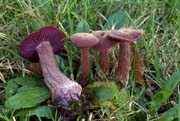
Steve Trudell |
2b Entire fruitbody not violet but mycelium at base of stem violet when young and fresh. Gills may be purplish or vinaceous.
................................................................................3
3a Cap small to moderate, finely fibrillose or occasionally scaly, stem fibrillose, cheilocystidia present
................................................................................L. bicolor
| CAP 8-70 mm broad, convex to plane, often depressed, not striate, finely fibrillose, fibrillose-scaly or occasionally scaly, hygrophanous, pinkish flesh colour, fading to buff colour; margin decurved to plane, entire to undulate, often eroded; flesh thin tapering quickly to margin, light vinaceous. ODOUR pleasant. TASTE pleasant. GILLS adnate to arched, subdistant to distant, broad, thick, light violaceous, fading to pinkish flesh colour, or then light flesh colour. STEM 23-85(-130) X 3-6(-10) mm, equal, subclavate or slightly bulbous, dry, fibrillose, longitudinally striate, concolorous with cap; striations concolorous with ground colour or slightly darker red brown. BASAL MYCELIUM copious, hygrophanous violet when fresh, becoming white. HABIT and HABITAT Scattered, occasionally cespitose. Very common on soil or in moss under conifers August to October in western North America. MICROSTRUCTURES Spores excluding ornamentation (5.5-)7-8.7(-10) X (5.5-)6-7.8(-9.2) Ám, subglobose to broadly ellipsoid, occasionally globose or ellipsoid, translucent, spiny; spines 1-1.8 Ám long, 0.4-1.2 Ám wide at base. Cheilocystidia 24.5-55 X 2.5-8 Ám, filamentous to subclavate, thin-walled, translucent, absent to abundant. Basidia 28.5-55 x 7.4-13 Ám, clavate, translucent; sterigmata 4, up to 9 Ám long; hilar appendix 1.3-2 Ám, prominent, truncate. EDIBILITY edible but not worthwhile. REMARKS storing fresh subalpine specimens that originally lack violet basal mycelia in a covered plastic container under refrigeration has resulted in new growth of violet mycelia. | Laccaria bicolor
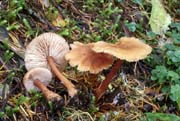
Steve Trudell |
3b Cap large, scaly to squarrose, stem conspicuously scaly, obvious cheilocystidia absent
................................................................................L. nobilis
| CAP 16-85 mm broad, convex to plane, occasionally becoming uplifted, depressed to deeply depressed, not striate, fibrillose-scaly becoming scaly to squarrose, reddish brown to brownish orange, occasionally darker at disc; margin incurved, decurved or plane, occasionally upturned, entire to eroded; flesh thin, concolorous with gills. GILLS sinuate to adnate, close to distant, thick, vinaceous to pinkish flesh colour. STEM (21-)26-110(-160) X 4-10(-16) mm, equal, slightly bulbous or subclavate, dry, fibrillose, with prominent longitudinal striations or reticulate ridges, often with apical recurved scales at maturity, concolorous with cap; striations concolorous with stem ground colour or somewhat darker reddish brown, robust, tough, solid, may become hollow. BASAL MYCELIUM violet, soon becoming white. HABIT and HABITAT solitary to scattered. Found infrequently under Pinaceae in western North America July to November. Associated with shrub Salix in mountains. MICROSTRUCTURES Spores white, excluding ornamentation (6.2-)6.6-9.7(-10.6) X (5)6.2-8.7 Ám, subglobose to broadly ellipsoid, occasionally globose or ellipsoid, transparent, spiny; spines 0.5-1.4 Ám long. Cheilocystidia lacking. Basidia 32-55 X 8-14 Ám, clavate, transparent; sterigmata 4, up to 9 Ám long. EDIBILITY unknown. REMARKS L. nobilis can be easily distinguished from others in the L. bicolor complex by its large size, scaly to squarrose cap, scaly stem, and lack of obvious cheilocystidia.
| Laccaria nobilis
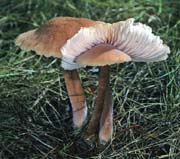
Michael Beug |
4a (1b) Fruitbodies small to large, cap striate or nonstriate, basidia bearing 4 small to moderate sized spores
................................................................................5
4b Fruitbodies small, cap striate, basidia bearing 2 large spores
................................................................................7
5a Fruitbodies small to moderate, cap not striate
................................................................................L. proxima
CAP (7-)15-69(-83) mm broad, campanulate to convex, often becoming plane to uplifted, some depressed, not striate, occasionally translucent-striate when faded, finely fibrillose to fibrillose, some becoming fibrillose-scaly to scaly or squarrose in age, hygrophanous, reddish brown to orange brown, fading lighter; margin incurved to decurved, sometimes plane, entire to undulate, occasionally becoming eroded in age; flesh thin, tapering quickly to margin, pinkish flesh colour. ODOUR pleasant. TASTE pleasant. GILLS sinuate to adnate, occasionally arched, subdistant to distant, thick, up to 10 mm, pinkish flesh colour. STEM (12-)24-72(-155) X 3-11 mm, equal, to subclavate, often slightly bulbous. Dry, fibrillose, often longitudinally striate, striations moderate to pronounced, most of stem concolorous with cap; base occasionally darker, striations concolorous with cap or darker red. BASAL MYCELIUM white. HABIT and HABITAT scattered to gregarious; terrestrial, associated most commonly with Pinaceae, occasionally among mosses including sphagnum; disturbed areas, mine tailings, early succession forests or under young planted pines in reforested areas. Cosmopolitan, common. Found throughout North America, August to October. MICROSTRUCTURES Spores white, excluding ornamentation 8-11(-12.5) X (6.5-)7-8.7(-9.2) Ám, broadly ellipsoid or ellipsoid or occasionally oblong, translucent, spiny; spines 0.5-1 Ám long, 0.2-0.8 Ám wide at base, appendix 1.3-2 Ám long, prominent, truncate. Basidia (23-)33-62 x 8-15 Ám, clavate, translucent; sterigmata 4, up to 7 Ám long. Cheilocystidia 19-66.5(-92) X 2.8.5(-16.5) Ám, filamentous to subclavate, occasionally subcapitate, often abundant, thin walled, translucent. EDIBILITY edible. REMARKS Caps of L. proxima are more robust, more strongly coloured and spores smaller and more finely spined than L. laccata; L. proxima varies also from L. laccata in having a non-striate and slightly scaly to scaly cap. L. proxima is also separated from L. montana in having smaller, more finely spined spores and more robust habit of its cap.
5b Fruitbodies small to moderate, cap striate
................................................................................6
6a Spores 8.5-14 Ám long, 7-12 Ám wide
................................................................................L. montana
| CAP 6-35 mm broad, convex to plane, becoming uplifted, often depressed, occasionally umbonate when young, usually plicate-striate when fresh, fibrillose to finely fibrillose to scaly, hygrophanous, brownish orange, fading to buff colour; margin decurved to plane, entire to undulate, occasionally becoming eroded; flesh 0.75-1 mm thick at disc, flesh colour. ODOUR not distinctive. TASTE not distinctive. GILLS sinuate to decurrent, close to distant, pinkish flesh colour to light vinaceous. STEM 13-54(-101) X 2-3(-7) mm equal or tapering slightly toward base or apex, occasionally swollen base, occasionally cespitose, dry, fibrillose, not striate to moderately longitudinally striate, concolorous with cap. BASAL MYCELIUM white, scant to moderately dense. HABIT and HABITAT scattered to gregarious, rarely solitary, occasionally cespitose; in poor soil, humus or among mosses, on stream banks and grassy areas often outside woodlands August to October; under Pinaceae, Betula, or Salix. Restricted to high elevations and northern latitudes, arctic and boreal distribution, common. MICROSTRUCTURES Spores white; excluding ornamentation (7.8-)8.5-14(-14.7) X (7-)8-12 Ám, globose to broadly ellipsoid, occasionally ellipsoid, translucent, spiny; spines (0.5-)0.9-1.8 Ám long, 0.75-1 Ám wide at base, not crowded to crowded; hilar appendix 1.3-2 Ám long, prominent, truncate. Basidia 34.5-55 X 10-15.5 Ám, clavate, translucent; sterigmata 4, up to 11 Ám long. Cheilocystidia lacking or very scarce, 32-55.5 X 3-4.5(-7.5) Ám, filamentous to subclavate, rarely clavate, thin-walled (only found in one collection by Mueller 1992). EDIBILITY unknown. REMARKS L. montana has larger spores than L. laccata and has arctic and boreal distribution. Macromorphologically L. montana is indistinguishable from L. tortilis and L. pumila. However, L. tortilis and L. pumila differ microscopically from L. montana by having 2-spored basidia. L. pumila also has slightly larger spores than L. montana. | Laccaria montana
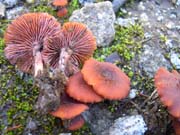
Andrew Parker |
6b Spores 7.5-10 Ám long, 7-10 Ám wide
................................................................................L. laccata
| CAP 10-45(-60) mm broad, obtuse to convex, often becoming plane to uplifted, often depressed, striate to non-striate, occasionally strongly striate to plicate-striate, sometimes translucent-striate when fresh, finely fibrillose to fibrillose-scaly, infrequently slightly scaly, hygrophanous, orange-brown when fresh, becoming buff colour; disc occasionally darker orange-brown or red-brown; margin incurved to decurved, becoming plane to uplifted, entire to undulate, occasionally becoming eroded in age; flesh thin, tapering quickly to margin, concolorous. ODOUR not distinctive. TASTE slight. GILLS sinuate, adnate or arched, rarely decurrent, close to distant, narrow to broad, relatively thin to thick, pinkish flesh colour, some becoming slightly vinaceous with age. STEM (12-)20-65(-106) X 2-4(-8) mm, equal, subclavate, or tapering towards base, occasionally slightly bulbous, dry, fibrillose, not striate to finely longitudinally striate, rarely with pronounced striations, concolorous with stem; context stuffed, becoming hollow, concolorous with cap flesh. BASAL MYCELIUM white, sparse to copious. HABIT and HABITAT solitary to gregarious, occasionally cespitose, associated with Pinaceae, Fagaceae and Betulaceae; cosmopolitan; abundant; June to November in poor soil. Found throughout North America. MICROSTRUCTURES Spores white; excluding ornamentation (6.4)-7.4-10(-13) X (6-)7-10(-11.5) Ám, globose to subglobose, occasionally broadly ellipsoid, translucent, spined; spines moderately coarse (0.5-)1-2 Ám long, 1 Ám wide at base, relatively scarce to crowded; hilar appendix 1.3-2.2 Ám long, prominent, truncate. Basidia 27.5-55 X7.5-13.5(-16.5) Ám, clavate, translucent; sterigmata 4, up to 7 Ám long. Cheilocystidia 23-55 X 2-7.5 Ám, filamentous to subclavate, occasionally strangulate, absent or scattered to abundant, translucent. EDIBILITY edible. REMARKS L. laccata can be distinguished from L. nobilis by being less robust. The stem of L. nobilis is basally enlarged to nearly clavate and is roughly fibrous-striate. Caps of L. proxima are more robust, more strongly coloured and spores smaller and more finely spined than L. laccata; L. proxima varies also from L. laccata in having a non-striate and slightly scaly to scaly cap. | Laccaria laccata
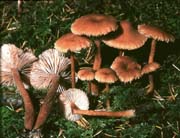
Sharon Godkin |
7a (4b) Cap very small to small (rarely up to 30 mm wide), often strongly striate, brownish-orange; gills pinkish-orange brown; stem 4-60(100) X 2-5(9) mm. Spores nearly round to broadly elliptic, occasionally round with spines <0.5-1.4(1.8) microns long
................................................................................L. pumila
CAP 3-27(-40) mm broad, convex to plane, occasionally uplifted, often depressed, usually strongly translucent-striate when fresh, glabrous to finely fibrillose, occasionally becoming fibrillose-scaly with age, hygrophanous, red-brown to orange-brown, fading to buff; margin incurved to decurved, often becoming plane, entire to undulate, occasionally becoming eroded; flesh thin, concolorous. GILLS sinuate to arched, distant, thick, waxy appearing, 8 mm broad, pinkish flesh colour. STEM 4-61(-100) X 2-5(-9) mm, equal to subclavate, often slightly bulbous, occasionally cespitose, dry, fibrillose, longitudinally striate, ▒ concolorous with cap, fading to ochraceous buff. BASAL MYCELIUM white. HABIT and HABITAT Scattered to gregarious, occasionally cespitose; in poor soil, humus or among mosses; under Pinaceae, Betula, or Salix; restricted to arctic, boreal, and montane regions, common. MICROSTRUCTURES Spores white; excluding ornamentation (10-)11-16.5(-20) X (7.8-)10-14.5(-16) Ám, subglobose to broadly ellipsoid, occasionally globose or ellipsoid, translucent, spiny; spines ?0.5-1.4(-1.8) Ám long, crowded; hilar appendix 1.3-2 Ám long, prominent, truncate. Basidia 37.5-64.5 X 10.5-16 Ám, clavate, translucent; sterigmata 2(-4), up to 14 Ám long. Cheilocystidia usually lacking, found in one collection only; 27.5-46 X 3 Ám, filamentous to subclavate, translucent. EDIBILITY unknown. REMARKS Can be distinguished from L. tortilis by having fewer globose spores with shorter, narrower spines. L. pumila can be distinguished from L. laccata by having larger, more broadly ellipsoid spores, and two-spored basidia. Macromorphologically L. montana is indistinguishable from L. tortilis and L. pumila. However, L. tortilis and L. pumila differ microscopically from L. montana by having 2-spored basidia. L. pumila also has slightly larger spores than L. montana. L. pumila appears to be the most common 2-sterigmate Laccaria found in the mountains of western United States.
7b Cap small (5-23 mm wide), strongly plicate-striate, vinaceous-brown to orange-brown; gills pinkish flesh colour to slightly vinaceous; stem 4-15 X 1-3.5 mm. Spores round, rarely nearly round, with spines 1.4-3.2(4) microns long
................................................................................L. tortilis
CAP 5-23 mm broad, convex, becoming plane to uplifted, strongly plicate-striate, subglabrous to finely fibrillose, hygrophanous, vinaceous brown to brownish orange fading lighter in colour eventually becoming buff; margin plane, undulate, eroded or rimose; flesh thin, concolorous. GILLS sinuate to adnate, distant, broad, thick, pinkish flesh colour to slightly vinaceous. STEM 4-15 X 1-3.5 mm, equal to subbulbous, dry, finely fibrillose, not striate, concolorous with cap. BASAL MYCELIUM white. HABIT and HABITAT Scattered to gregarious, occasionally cespitose, often on bare, poorly drained soil, apparently associated with Pinaceae and Fagaceae; cosmopolitan. Found throughout much of the United States and Canada outside of arctic habitats, not common. Also found in subalpine habitats. MICROSTRUCTURES Spores white; excluding ornamentation (9.2-) 10-14.5(-16) X (8.3-)10-14.5(-16) Ám, globose, rarely subglobose, translucent, strongly spiny; spines 1.4-3.2(-4) Ám long, up to 2.3 Ám wide at base, crowded; hilar appendix 1.3-2.3 Ám long, prominent, truncate. Basidia 33-64 X 7-16 Ám, clavate, translucent; sterigmata 2(-3), up to 11.5 Ám long. Cheilocystidia lacking or scarce; filamentous. EDIBILITY unknown. REMARKS L. tortilis can be distinguished from other small, plicate-striate Laccaria by its 2-sterigmate basidia bearing large, globose spores with long, broad spines.
REFERENCES
- Arora, D. 1986. Mushrooms Demystified. Berkley CA: Ten Speed Press.
- Mueller, G.M. 1991. Laccaria laccata complex in North America and Sweden: intercollection pairing and morphometric analyses. Mycologia 83(5): 578-594.
- Mueller, G.M. 1992. Systematics of Laccaria (Agaricales) in the continental United States and Canada, with discussions on extralimital taxa and descriptions of extant types. Fieldiana, Botany, New Series 30:1-158.
- Osmundson, T.W., C.L. Cripps. 2005. Morphological and molecular systematics of Rocky Mountain alpine Laccaria. Mycologia 97(5): 949-972.
- Phillips, R. 1991. Mushrooms of North America. Boston, Little, Brown and Co.
INDEX
| SPECIES |
KEY ENTRIES |
| |
|
| LACCARIA Berk. & Broome |
|
| L. amethysteo-occidentalis G.M. Muell. |
2a |
| L. bicolor (Maire) P.D. Orton |
3a |
| L. laccata (Scop.) Cooke |
6b |
| L. montana Singer |
6a |
| L. nobilis A.H. Sm. |
3b |
| L. proxima (Boud.) Pat. |
5a |
| L. pumila Fayod |
7a |
| L. tortilis (Bolton) Cooke |
7b |
- END -

